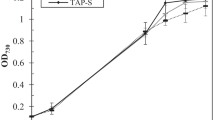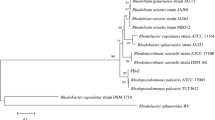Abstract
Hydrogen represents a possible alternative energy carrier to face the growing request for energy and the shortage of fossil fuels. Photofermentation for the production of H2 constitutes a promising way for integrating the production of energy with waste treatments. Many wastes are characterized by high salinity, and polluted seawater can as well be considered as a substrate. Moreover, the application of seawater for bacterial culturing is considered cost-effective. The aims of this study were to assess the capability of the metabolically versatile freshwater Rhodopseudomonas palustris 42OL of producing hydrogen on salt-containing substrates and to investigate its salt stress response strategy, never described before. R. palustris 42OL was able to produce hydrogen in media containing up to 3 % added salt concentration and to grow in media containing up to 4.5 % salinity without the addition of exogenous osmoprotectants. While the hydrogen production performances in absence of sea salts were higher than in their presence, there was no significant difference in performances between 1 and 2 % of added sea salts. Nitrogenase expression levels indicated that the enzyme was not directly inhibited during salt stress, but a regulation of its expression may have occurred in response to salt concentration increase. During cell growth and hydrogen production in the presence of salts, trehalose was accumulated as a compatible solute; it protected the enzymatic functionality against salt stress, thus allowing hydrogen production. The possibility of producing hydrogen on salt-containing substrates widens the range of wastes that can be efficiently used in production processes.




Similar content being viewed by others
References
Adessi A, De Philippis R (2014) Photobioreactor design and illumination systems for H2 production with anoxygenic photosynthetic bacteria: a review. Int J Hydrog Energy 39:3127–3141. doi:10.1016/j.ijhydene.2013.12.084
Adessi A, De Philippis R, Hallenbeck PC (2012a) Combined systems for maximum substrate conversion. In: Hallenbeck PC (ed) Microbial technologies in advanced biofuels production. Springer, New York, pp 107–126
Adessi A, Torzillo G, Baccetti E, De Philippis R (2012b) Sustained outdoor H2 production with Rhodopseudomonas palustris cultures in a 50 L tubular photobioreactor. Int J Hydrog Energy 37:8840–8849. doi:10.1016/j.ijhydene.2012.01.081
APHA (1992) Standard methods for the examination of water and wastewater. American Public Health Association, Washington
Arguelles JC (2000) Physiological roles of trehalose in bacteria and yeasts: a comparative analysis. Arch Microbiol 174:217–224. doi:10.1007/s002030000192
Bianchi L, Mannelli F, Viti C, Adessi A, De Philippis R (2010) Hydrogen-producing purple non-sulfur bacteria isolated from the trophic lake Averno (Naples, Italy). Int J Hydrog Energy 35:12216–12223. doi:10.1016/j.ijhydene.2010.08.038
Burgess JG, Kawaguchi R, Yamada A, Matsunaga T (1994) Rhodobacter marinus sp. nov.: a new marine hydrogen producing photosynthetic bacterium which is sensitive to oxygen and sulphide. Microbiology 140:965–970
Cai J, Wang G (2012) Hydrogen production by a marine photosynthetic bacterium, Rhodovulum sulfidophilum P5, isolated from a shrimp pond. Int J Hydrog Energy 37:15070–15080. doi:10.1016/j.ijhydene.2012.07.130
Cai J, Wang G (2013) Screening and hydrogen-producing characters of a highly efficient H2-producing mutant of Rhodovulum sulfidophilum P5. Bioresour Technol 142:18–25. doi:10.1016/j.biortech.2013.05.009
Cai J, Wang G (2014) Photo-biological hydrogen production by an acid tolerant mutant of Rhodovulum sulfidophilum P5 generated by transposon mutagenesis. Bioresour Technol 154:254–259. doi:10.1016/j.biortech.2013.12.057
Cai J, Wang G, Pan G (2012) Hydrogen production from butyrate by a marine mixed phototrophic bacterial consort. Int J Hydrog Energy 37:4057–4067. doi:10.1016/j.ijhydene.2011.11.101
Carlozzi P, Buccioni A, Minieri S, Pushparai B, Piccardi R, Ena A, Pintucci C (2010) Production of bio-fuels (hydrogen and lipids) through a photofermentation process. Bioresour Technol 101:3115–3120. doi:10.1016/j.biortech.2009.12.049
Dipasquale L, Adessi A, d’Ippolito G, Rossi F, Fontana A, De Philippis R (2014) Introducing capnophilic lactic fermentation in a combined dark-photo fermentation process: a route to unparalleled H2 yields. Appl Microbiol Biotechnol 99:1001–1010. doi:10.1007/s00253-014-6231-4
Galinski EA (1993) Compatible solutes of halophilic eubacteria: molecular principles, water-solute interaction, stress protection. Experientia 49:487–496. doi:10.1007/BF01955150
Gómez X, Fernández C, Fierro J, Sánchez ME, Escapa A, Morán A (2011) Hydrogen production: two stage processes for waste degradation. Bioresour Technol 102:8621–8627. doi:10.1016/j.biortech.2011.03.055
Hallenbeck PC (2014) Bioenergy from microorganisms: an overview. In: Zannoni D, De Philippis R (eds) Microbial bioenergy: hydrogen production. Springer, Dordrecht, pp 3–21
Hallenbeck PC, Abo-Hashesh M, Ghosh D (2012) Strategies for improving biological hydrogen production. Bioresour Technol 110:1–9. doi:10.1016/j.biortech.2012.01.103
He D, Bultel Y, Magnin J-P, Willison JC (2006) Kinetic analysis of photosynthetic growth and photohydrogen production of two strains of Rhodobacter capsulatus. Enzyme Microb Technol 38:253–259. doi:10.1016/j.enzmictec.2005.06.012
Hosseinkhani B, Hennebel T, Boon N (2014) Potential of biogenic hydrogen production for hydrogen driven remediation strategies in marine environments. New Biotechnol 31:445–450. doi:10.1016/j.nbt.2014.04.005
Igeno MI, Del Moral CG, Castillo F, Caballero FJ (1995) Halotolerance of the phototrophic bacterium Rhodobacter capsulatus E1F1 is dependent on the nitrogen source. Appl Environ Microbiol 61:2970–2975
Ike A, Toda N, Tsuji N, Hirata K, Miyamoto K (1997) Hydrogen photoproduction from CO2-fixing microalgal biomass: application of halotolerant photosynthetic bacteria. J Ferment Bioeng 84:606–609
Ike A, Murakawa T, Kawaguchi H, Hirata K, Miyamoto K (1999) Photoproduction of hydrogen from raw starch using a halophilic bacterial community. J Biosci Bioeng 88:72–77
Imhoff JF (1992) Taxonomy, phylogeny, and general ecology of anoxygenic phototrophic bacteria. In: Mann NH, Carr NG (eds) Photosynthetic prokaryotes. Springer, New York, pp 53–92
Imhoff JF, Trüper HG (1992) In: Balows A, Trüper HG, Dworkin M, Harder W, Schleifer KH (eds) The genus Rhodospirillum and related genera. Springer, New York, pp 2141–2155
Imhoff JF (1993) Osmotic adaptation in halophilic and halotolerant microorganisms. In: Vreeland RH, Hochstein LI (eds) The biology of halophilic bacteria. CRC Press, Boca Raton, pp 211–254
Kapdan IK, Kargi F (2006) Bio-hydrogen production from waste materials. Enzyme Microb Technol 38:569–582. doi:10.1016/j.enzmictec.2005.09.015
Keskin T, Abo-Hashesh M, Hallenbeck PC (2011) Photofermentative hydrogen production from wastes. Bioresour Technol 102:8557–8568. doi:10.1016/j.biortech.2011.04.004
Koku H, Eroǧlu İ, Gündüz U, Yücel M, Türker L (2003) Kinetics of biological hydrogen production by the photosynthetic bacterium Rhodobacter sphaeroides OU 001. Int J Hydrog Energy 28:381–388
Larimer FW, Chain P, Hauser L, Lamerdin J, Malfatti S, Do L, Land ML, Pelletier DA, Beatty JT, Lang AS, Tabita FR, Gibson JL, Hanson TE, Bobst C, Torres y Torres JL, Peres C, Harrison FH, Gibson J, Harwood CS (2004) Complete genome sequence of the metabolically versatile photosynthetic bacterium Rhodopseudomonas palustris. Nat Biotechnol 22:55–61. doi:10.1038/nbt923
Maeda I, Mizoguchi T, Miura Y (2000) Influence of sulfate-reducing bacteria on outdoor hydrogen production by photosynthetic bacterium with seawater. Curr Microbiol 40:210–213. doi:10.1007/s002849910042
Makihara F, Tsuzuki M, Sato K, Masuda S, Nagashima KVP, Abo M, Okubo A (2005) Role of trehalose synthesis pathways in salt tolerance mechanism of Rhodobacter sphaeroides f. sp. denitrificans IL106. Arch Microbiol 184:56–65. doi:10.1007/s00203-005-0012-5
Matsunaga T, Matsunaga N, Tsubaki K, Tanaka T (1986) Development of a gene cloning system for the hydrogen-producing marine photosynthetic bacterium Rhodopseudomonas sp. J Bacteriol 168:460–463
Matsunaga T, Hatano T, Yamada A, Matsumoto M (2000) Microaerobic hydrogen production by photosynthetic bacteria in a double-phase photobioreactor. Biotechnol Bioeng 68:647–651. doi:10.1002/(SICI)1097-0290(20000620)68:63.0.CO;2-8
McKinlay JB, Oda Y, Rühl M, Posto AL, Sauer U, Harwood CS (2014) Non-growing Rhodopseudomonas palustris increases the hydrogen gas yield from acetate by shifting from the glyoxylate shunt to the tricarboxylic acid cycle. J Biol Chem 289:1960–1970. doi:10.1074/jbc.M113.527515
Melnicki MR, Bianchi L, De Philippis R, Melis A (2008) Hydrogen production during stationary phase in purple photosynthetic bacteria. Int J Hydrogen Energ 33:6525–6534. doi:10.1016/j.ijhydene.2008.08.041
Patel SKS, Kalia VC (2013) Integrative biological hydrogen production: an overview. Indian J Microbiol 53:3–10. doi:10.1007/s12088-012-0287-6
Redwood MD, Paterson-Beedle M, Macaskie LE (2009) Integrating dark and light bio-hydrogen production strategies: towards the hydrogen economy. Rev Environ Sci Biotechnol 8:149--185. doi:10.1007/s11157-008-9144-9
Reina-Bueno M, Argandoña M, Salvador M, Javier R-M, Iglesias-Guerra F, Csonka LN, Nieto JJ, Vargas C (2012) Role of trehalose in salinity and temperature tolerance in the model halophilic bacterium Chromohalobacter salexigens. PLoS ONE 7:e33587. doi:10.1371/journal.pone.0033587
Tsuzuki M, Moskvin OV, Kuribayashi M, Sato K, Retamal S, Abo M, Zeilstra-Ryalls J, Gomelsky M (2011) Salt stress-induced changes in the transcriptome, compatible solutes, and membrane lipids in the facultatively phototrophic bacterium Rhodobacter sphaeroides. Appl Environ Microbiol 77:7551–7559. doi:10.1128/AEM.05463-11
Vincenzini M, Marchini A, Ena A, De Philippis R (1997) H2 and poly-β-hydroxybutyrate, two alternative chemicals from purple non sulfur bacteria. Biotechnol Lett 19:759–762. doi:10.1023/A:1018336209252
Weber J, Krujatz F, Hilpmann G, Grützner S, Herrmann J, Thierfeld S, Bienert G, Illing R, Helbig K, Hurtado A, Cuniberti G, Mertig M, Lange R, Günther E, Optiz J, Lippmann W, Bley T, Haufe N (2014) Biotechnological hydrogen production by photosynthesis. Eng Life Sci 14:592–606. doi:10.1002/elsc.201400056
Welsh DT, Herbert RA (1993) Identification of organic solutes accumulated by purple and green sulphur bacteria during osmotic stress using natural abundance 13C nuclear magnetic resonance spectroscopy. FEMS Microbiol Ecol 13:145–149. doi:10.1111/j.1574-6941.1993.tb00060.x
Acknowledgments
The authors gratefully acknowledge Dr. Maura Calvani for her support in running western blotting analysis. The authors acknowledge CNR (Italian National Research Council) (EFOR project) and Ente Cassa di Risparmio di Firenze (Project HYDROLAB2) for funding the fellowship to AA. RDP would also like to mention the contribution given to his activities by the participation in the IEA-HIA (International Energy Agency - Hydrogen Implementation Agreement), Annex 34.
Author information
Authors and Affiliations
Corresponding author
Ethics declarations
Conflict of interest
The authors declare that they have no competing interests.
Ethical statement
This article does not contain any studies with human participants or animals performed by any of the authors.
Rights and permissions
About this article
Cite this article
Adessi, A., Concato, M., Sanchini, A. et al. Hydrogen production under salt stress conditions by a freshwater Rhodopseudomonas palustris strain. Appl Microbiol Biotechnol 100, 2917–2926 (2016). https://doi.org/10.1007/s00253-016-7291-4
Received:
Revised:
Accepted:
Published:
Issue Date:
DOI: https://doi.org/10.1007/s00253-016-7291-4




